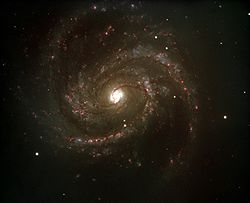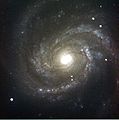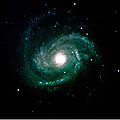- Messier 100
-
Messier 100 
Observation data (J2000 epoch) Constellation Coma Berenices[1] Right ascension 12h 22m 54.9s[2] Declination +15° 49′ 21″[2] Redshift 1571 ± 1 km/s[2] Distance 55 Mly[3] Type SAB(s)bc[2] Apparent dimensions (V) 7′.4 × 6′.3[2] Apparent magnitude (V) 10.1[2] Other designations NGC 4321 See also: Galaxy, List of galaxies Messier 100 (also known as NGC 4321) is an example of a grand design spiral galaxy[4] located within the southern part of constellation Coma Berenices. It is one of the brightest galaxies in the Virgo cluster, approximately 55 million light-years[3] distant from Earth and has a diameter of 160,000 light years. It was discovered by Pierre Méchain on March 15, 1781 and was subsequently entered in Messier’s catalogue of nebulae and star clusters[5] after Charles Messier[6] made observations of his own on April 13, 1781. The galaxy was one of the first spirals[6] discovered, and was listed as 1 of 14 spiral nebulae by Lord William Parsons of Rosse in 1850. A satellite galaxy[7][8] named NGC 4323 is present within M100.
Contents
Early observations
After the discovery of M100 by Méchain, Charles Messier made observations of the galaxy depicting it as a nebula without a star. He pointed out that it was difficult[6] to recognize the nebula because of its faintness. William Herschel was able to identify a bright cluster of stars[6] within the nebula during observations he did before John Herschel expanded the findings in 1833. With the advent of better telescopes, John Herschel was able to see a round, brighter galaxy; however, he also mentioned that it was barely visible through clouds but he still indicated that it was faint. William Henry Smyth[6] extended the studies of M100, detailing it as a pearly white nebula and pointing out diffuse spots.
Supernovae
Five supernovae[4] have been identified in the M100 galaxy. In March 1901 the first supernova of M100 was found, SN 1901B,[4][9] a type I supernova found when magnitude 15.6 at a distance from its nucleus. SN 1914A[4][10] was then discovered in February to March 1914; its type was undeterminable but was found when magnitude 15.7 at some distance from the center. Observations of M100 from February 21, 1960 to June 17, 1960 led to the discovery of SN 1959E, another type I supernova,[4][11] with the faintest magnitude, 17.5, among the five found, at 58"E and 21"S from its nucleus. On April 15, 1979, the first type II supernova found in the M100 galaxy was discovered; however the star SN 1979C[4][12] faded quickly; later observations from x-ray to radio wavelengths revealed its remnant. The latest supernova was discovered February 7, 2006; the star SN 2006X[4][13] had a magnitude of 15.3 when discovered two weeks before fading to magnitude +17.
Images
-
Infrared light with the HAWK-I camera on ESO's Very Large Telescope.
References
- ^ R. W. Sinnott, ed (1988). The Complete New General Catalogue and Index Catalogue of Nebulae and Star Clusters by J. L. E. Dreyer. Sky Publishing Corporation/Cambridge University Press. ISBN 0-933-34651-4.
- ^ a b c d e f "NASA/IPAC Extragalactic Database". Results for NGC 4321. http://nedwww.ipac.caltech.edu/. Retrieved 2006-08-31.
- ^ a b "Messier 100". Hearst Observatory. http://www.hearstobservatory.com/messier_100.html. Retrieved 2010-02-23.
- ^ a b c d e f g "Messier 100". SEDS: Spiral Galaxy M100 (NGC 4321), type Sc, in Coma Berenices. http://seds.org/messier/m/m100.html. Retrieved 2010-02-23.
- ^ "Catalog of Nebulae and Star Clusters". SEDS. http://seds.org/MESSIER/xtra/history/m-cat.html#M100. Retrieved 2010-02-23.[dead link]
- ^ a b c d e "Messier 100". SEDS: Observations and Descriptions. http://seds.org/MESSIER/Mdes/dm100.html. Retrieved 2010-02-23.[dead link]
- ^ S. di Serego Alighieri et al. (2007). "The HI content of Early-Type Galaxies from the ALFALFA survey I. Catalogued HI sources in the Virgo cluster". Astronomy and Astrophysics 474 (3). arXiv:0709.2096. Bibcode 2007A&A...474..851D. doi:10.1051/0004-6361:20078205.
- ^ NGC 4323 "NGC 4323". SIMBAD. http://SIMBAD.u-strasbg.fr/SIMBAD/sim-id?protocol=html&Ident=NGC+4323&NbIdent=1&Radius=2&Radius.unit=arcmin&submit=submit+id NGC 4323. Retrieved 2010-02-23.
- ^ "SN 1901B -- SuperNova". SIMBAD. http://SIMBAD.u-strasbg.fr/SIMBAD/sim-id?protocol=html&Ident=SN+1901B&NbIdent=1&Radius=2&Radius.unit=arcmin&submit=submit+id. Retrieved 2010-02-23.
- ^ "SN 1914A -- SuperNova". SIMBAD. http://SIMBAD.u-strasbg.fr/SIMBAD/sim-id?Ident=SN+1914A&NbIdent=1&Radius=2&Radius.unit=arcmin&submit=submit+id. Retrieved 2010-02-23.
- ^ "SN 1959E -- SuperNova". SIMBAD. http://SIMBAD.u-strasbg.fr/SIMBAD/sim-id?Ident=SN+1959E&NbIdent=1&Radius=2&Radius.unit=arcmin&submit=submit+id. Retrieved 2010-02-23.
- ^ "SN 1979C -- SuperNova". SIMBAD. http://SIMBAD.u-strasbg.fr/SIMBAD/sim-id?Ident=SN+1979C&NbIdent=1&Radius=2&Radius.unit=arcmin&submit=submit+id. Retrieved 2010-02-23.
- ^ "SN 2006X -- SuperNova". SIMBAD. http://SIMBAD.u-strasbg.fr/SIMBAD/sim-id?Ident=SN+2006X&NbIdent=1&Radius=2&Radius.unit=arcmin&submit=submit+id. Retrieved 2010-02-23.
External links
- SEDS: Spiral Galaxy 100
- Messier 100 on WikiSky: DSS2, SDSS, GALEX, IRAS, Hydrogen α, X-Ray, Astrophoto, Sky Map, Articles and images
- ESA/Hubble Messier 100
Coordinates:
 12h 22m 54.9s, +15° 49′ 21″
12h 22m 54.9s, +15° 49′ 21″Messier objects List M1 · M2 · M3 · M4 · M5 · M6 · M7 · M8 · M9 · M10 · M11 · M12 · M13 · M14 · M15 · M16 · M17 · M18 · M19 · M20 · M21 · M22 · M23 · M24 · M25 · M26 · M27 · M28 · M29 · M30 · M31 · M32 · M33 · M34 · M35 · M36 · M37 · M38 · M39 · M40 · M41 · M42 · M43 · M44 · M45 · M46 · M47 · M48 · M49 · M50 · M51 · M52 · M53 · M54 · M55 · M56 · M57 · M58 · M59 · M60 · M61 · M62 · M63 · M64 · M65 · M66 · M67 · M68 · M69 · M70 · M71 · M72 · M73 · M74 · M75 · M76 · M77 · M78 · M79 · M80 · M81 · M82 · M83 · M84 · M85 · M86 · M87 · M88 · M89 · M90 · M91 · M92 · M93 · M94 · M95 · M96 · M97 · M98 · M99 · M100 · M101 · M102 · M103 · M104 · M105 · M106 · M107 · M108 · M109 · M110See also  Book:Messier objects ·
Book:Messier objects ·  Category:Messier objects
Category:Messier objects  Portal:AstronomyCategories:
Portal:AstronomyCategories:- Spiral galaxies
- Intermediate spiral galaxies
- Virgo Cluster
- Coma Berenices constellation
- Messier objects
- NGC objects
-
Wikimedia Foundation. 2010.







